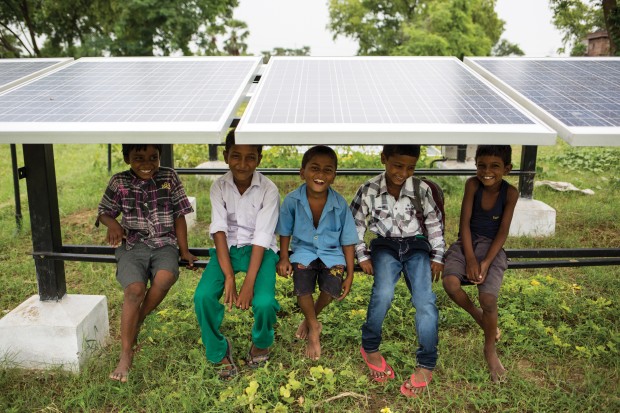Once struggling to get basic electricity like most villages in India, Dharnai has now changed its fate and become the first village in India to completely run on solar power. The project by Greenpeace not only powers residential homes but also street lights, hospitals, schools and commercial buildings. Read the story of Dharnai to know how they did it.
Children cut short their “play time” to rush home and finish their studies, women cook dinner before the sun sets and all important work is done before 6 pm because the dark streets aren’t safe. This is a common scenario in many Indian villages. While the cities get access to 3G and 4G connectivity, rural India is still struggling for basic electricity.
But, Dharnai is not one of them now. How did this small village in Bihar, which lived in darkness for 30 years, light up its homes and streets?

Residents of Dharnai have been using diesel-based generators and hazardous fuel like cow dung to meet the electricity requirement for decades, which were both costly and unhealthy. Over four million people die prematurely from sickness due to household air pollution caused by cooking with these dangerous fuels.
Dharnai, which had no electricity for three decades, now looks different as it declared itself an energy-independent village this July and became the first fully solar-powered village in India. There are electric poles all around, well-lit houses, bright streets and hopes for a better future.
Initiated by Greenpeace India, a non-profit organization, a solar-powered 100 kilowatt micro-grid was installed to provide regular and quality electricity to over 2,400 residents of this village. This was done with the help of NGOs BASIX and CEED. Within 3 months, the micro-grid was able to meet the electricity requirement of the entire village that includes 450 houses, 50 commercial buildings, 2 schools, 60 street lights, 1 health centre and 1 Kisan training centre.
This development has changed the fate of the village. As students get good lighting both at home and at schools, education opportunities have increased. Also, women do not have to struggle to meet the basic needs of fuel, water and food. The community is safer at night as the darkest corners are now well lit.
Apart from meeting the daily requirements of the villagers, this change has also created livelihood opportunities for them as many people have been employed for the operation and maintenance of the grid. The residents of Dharnai can also work for longer hours now, which has increased their revenue potential.
India, being a tropical country, gets abundant solar raditaion for around 300 days which is equivalent to 5000 trillion kilo Watt hours. If used in an efficient way, the country can fulfill most of its energy requirements through solar energy.
Greenpeace made it possible in such a short period of time and with limited funds. If the same model is replicated in other villages, thousands of villages like Dharnai could see a brighter future.
It is sad to see that even today, a majority of rural areas have to struggle for meeting their basic needs. Dharnai’s story is an inspiration to all and the beginning of a bigger change.
Watch this video to know more about Dharnai’s story of success-
All photographs: Source
Like this story? Or have something to share? Write to us: contact@thebetterindia.com, or connect with us on Facebook and Twitter (@thebetterindia).
If you found our stories insightful, informative, or even just enjoyable, we invite you to consider making a voluntary payment to support the work we do at The Better India. Your contribution helps us continue producing quality content that educates, inspires, and drives positive change.
Choose one of the payment options below for your contribution-
By paying for the stories you value, you directly contribute to sustaining our efforts focused on making a difference in the world. Together, let's ensure that impactful stories continue to be told and shared, enriching lives and communities alike.
Thank you for your support. Here are some frequently asked questions you might find helpful to know why you are contributing?
